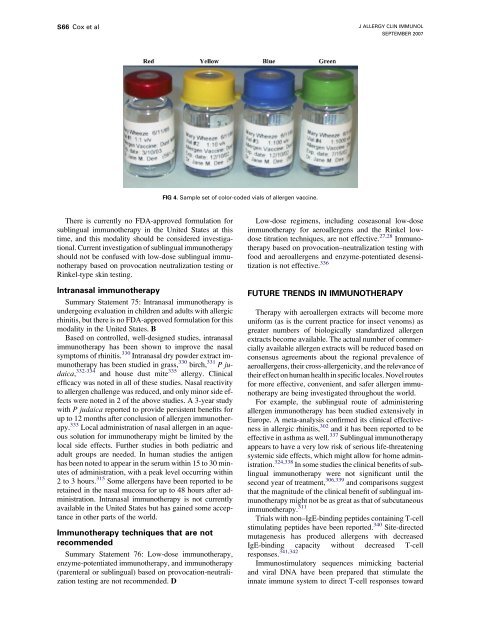Immunotherapy Safety for the Primary Care ... - U.S. Coast Guard
Immunotherapy Safety for the Primary Care ... - U.S. Coast Guard
Immunotherapy Safety for the Primary Care ... - U.S. Coast Guard
You also want an ePaper? Increase the reach of your titles
YUMPU automatically turns print PDFs into web optimized ePapers that Google loves.
S66 Cox et al<br />
J ALLERGY CLIN IMMUNOL<br />
SEPTEMBER 2007<br />
FIG 4. Sample set of color-coded vials of allergen vaccine.<br />
There is currently no FDA-approved <strong>for</strong>mulation <strong>for</strong><br />
sublingual immuno<strong>the</strong>rapy in <strong>the</strong> United States at this<br />
time, and this modality should be considered investigational.<br />
Current investigation of sublingual immuno<strong>the</strong>rapy<br />
should not be confused with low-dose sublingual immuno<strong>the</strong>rapy<br />
based on provocation neutralization testing or<br />
Rinkel-type skin testing.<br />
Intranasal immuno<strong>the</strong>rapy<br />
Summary Statement 75: Intranasal immuno<strong>the</strong>rapy is<br />
undergoing evaluation in children and adults with allergic<br />
rhinitis, but <strong>the</strong>re is no FDA-approved <strong>for</strong>mulation <strong>for</strong> this<br />
modality in <strong>the</strong> United States. B<br />
Based on controlled, well-designed studies, intranasal<br />
immuno<strong>the</strong>rapy has been shown to improve <strong>the</strong> nasal<br />
symptoms of rhinitis. 330 Intranasal dry powder extract immuno<strong>the</strong>rapy<br />
has been studied in grass, 330 birch, 331 P judaica,<br />
332-334 and house dust mite 335 allergy. Clinical<br />
efficacy was noted in all of <strong>the</strong>se studies. Nasal reactivity<br />
to allergen challenge was reduced, and only minor side effects<br />
were noted in 2 of <strong>the</strong> above studies. A 3-year study<br />
with P judaica reported to provide persistent benefits <strong>for</strong><br />
up to 12 months after conclusion of allergen immuno<strong>the</strong>rapy.<br />
333 Local administration of nasal allergen in an aqueous<br />
solution <strong>for</strong> immuno<strong>the</strong>rapy might be limited by <strong>the</strong><br />
local side effects. Fur<strong>the</strong>r studies in both pediatric and<br />
adult groups are needed. In human studies <strong>the</strong> antigen<br />
has been noted to appear in <strong>the</strong> serum within 15 to 30 minutes<br />
of administration, with a peak level occurring within<br />
2 to 3 hours. 315 Some allergens have been reported to be<br />
retained in <strong>the</strong> nasal mucosa <strong>for</strong> up to 48 hours after administration.<br />
Intranasal immuno<strong>the</strong>rapy is not currently<br />
available in <strong>the</strong> United States but has gained some acceptance<br />
in o<strong>the</strong>r parts of <strong>the</strong> world.<br />
<strong>Immuno<strong>the</strong>rapy</strong> techniques that are not<br />
recommended<br />
Summary Statement 76: Low-dose immuno<strong>the</strong>rapy,<br />
enzyme-potentiated immuno<strong>the</strong>rapy, and immuno<strong>the</strong>rapy<br />
(parenteral or sublingual) based on provocation-neutralization<br />
testing are not recommended. D<br />
Low-dose regimens, including coseasonal low-dose<br />
immuno<strong>the</strong>rapy <strong>for</strong> aeroallergens and <strong>the</strong> Rinkel lowdose<br />
titration techniques, are not effective. 27,28 <strong>Immuno<strong>the</strong>rapy</strong><br />
based on provocation–neutralization testing with<br />
food and aeroallergens and enzyme-potentiated desensitization<br />
is not effective. 336<br />
FUTURE TRENDS IN IMMUNOTHERAPY<br />
Therapy with aeroallergen extracts will become more<br />
uni<strong>for</strong>m (as is <strong>the</strong> current practice <strong>for</strong> insect venoms) as<br />
greater numbers of biologically standardized allergen<br />
extracts become available. The actual number of commercially<br />
available allergen extracts will be reduced based on<br />
consensus agreements about <strong>the</strong> regional prevalence of<br />
aeroallergens, <strong>the</strong>ir cross-allergenicity, and <strong>the</strong> relevance of<br />
<strong>the</strong>ir effect on human health in specific locales. Novel routes<br />
<strong>for</strong> more effective, convenient, and safer allergen immuno<strong>the</strong>rapy<br />
are being investigated throughout <strong>the</strong> world.<br />
For example, <strong>the</strong> sublingual route of administering<br />
allergen immuno<strong>the</strong>rapy has been studied extensively in<br />
Europe. A meta-analysis confirmed its clinical effectiveness<br />
in allergic rhinitis, 302 and it has been reported to be<br />
effective in asthma as well. 337 Sublingual immuno<strong>the</strong>rapy<br />
appears to have a very low risk of serious life-threatening<br />
systemic side effects, which might allow <strong>for</strong> home administration.<br />
324,338 In some studies <strong>the</strong> clinical benefits of sublingual<br />
immuno<strong>the</strong>rapy were not significant until <strong>the</strong><br />
second year of treatment, 306,339 and comparisons suggest<br />
that <strong>the</strong> magnitude of <strong>the</strong> clinical benefit of sublingual immuno<strong>the</strong>rapy<br />
might not be as great as that of subcutaneous<br />
immuno<strong>the</strong>rapy. 311<br />
Trials with non–IgE-binding peptides containing T-cell<br />
stimulating peptides have been reported. 340 Site-directed<br />
mutagenesis has produced allergens with decreased<br />
IgE-binding capacity without decreased T-cell<br />
responses. 341,342<br />
Immunostimulatory sequences mimicking bacterial<br />
and viral DNA have been prepared that stimulate <strong>the</strong><br />
innate immune system to direct T-cell responses toward
















